Abstract
1. The daily urinary excretion of normetadrenaline, metadrenaline, 4-hydroxy-3-methoxyphenylglycol, 4-hydroxy-3-methoxymandelic acid, dopamine, homovanillic acid, 5-hydroxytryptamine and 5-hydroxyindolylacetic acid has been estimated in the urine of immunosympathectomized and control rats.
2. A method is given which allows separate spectrophotometric determination of 4-hydroxy-3-methoxyphenylglycol and 4-hydroxy-3-methoxymandelic acid in the same sample of rat urine. Metadrenaline and normetadrenaline were estimated by a modification of the method of Anton & Sayre (1966).
3. Approximately 17% of the 4-hydroxy-3-methoxymandelic acid in rat urine is excreted in the free state, over 60% as a glucuronide conjugate and the remainder as a sulphate conjugate.
4. Urinary excretion of 4-hydroxy-3-methoxyphenylglycol was approximately halved in immunosympathectomized rats (P<0·001). 4-Hydroxy-3-methoxymandelic acid output was significantly increased in treated animals (P<0·05) when expressed in terms of body weight. No significant difference was detected for any of the other compounds investigated.
5. The results are discussed in the light of previous knowledge of the effect of immunosympathectomy on catecholamine metabolism.
Full text
PDF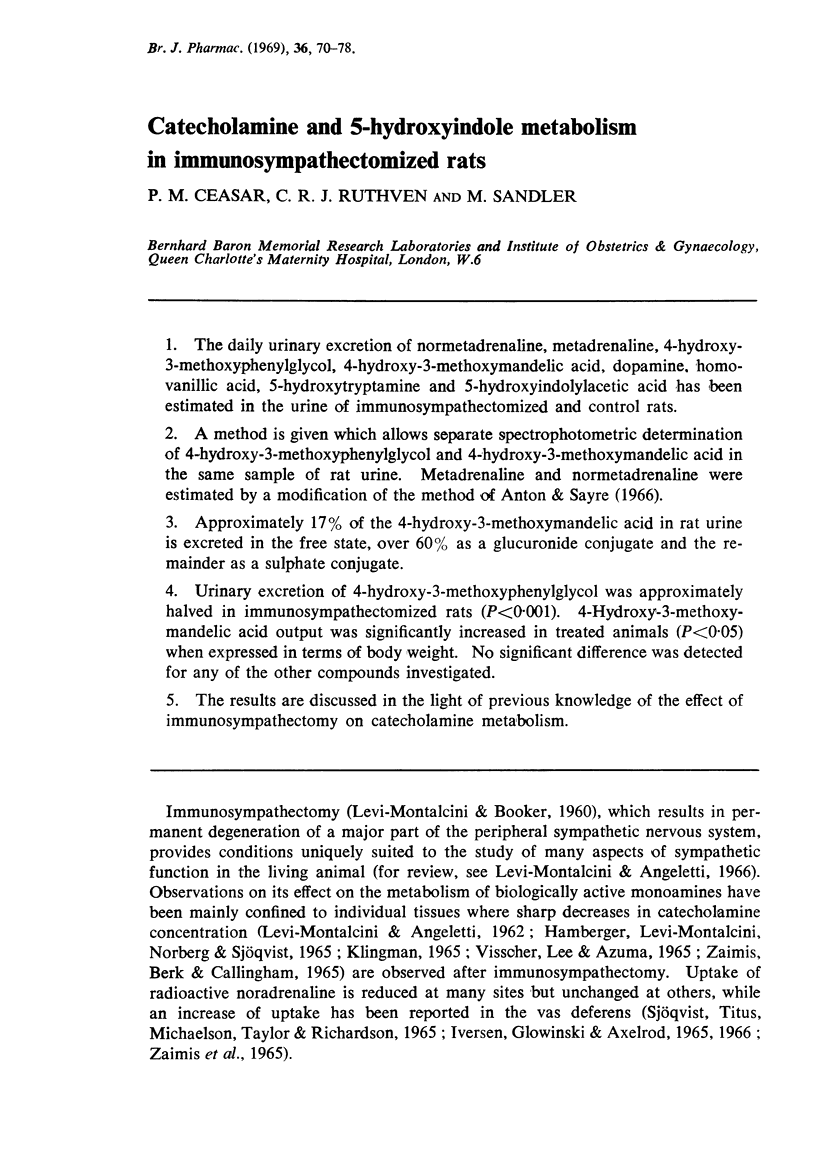
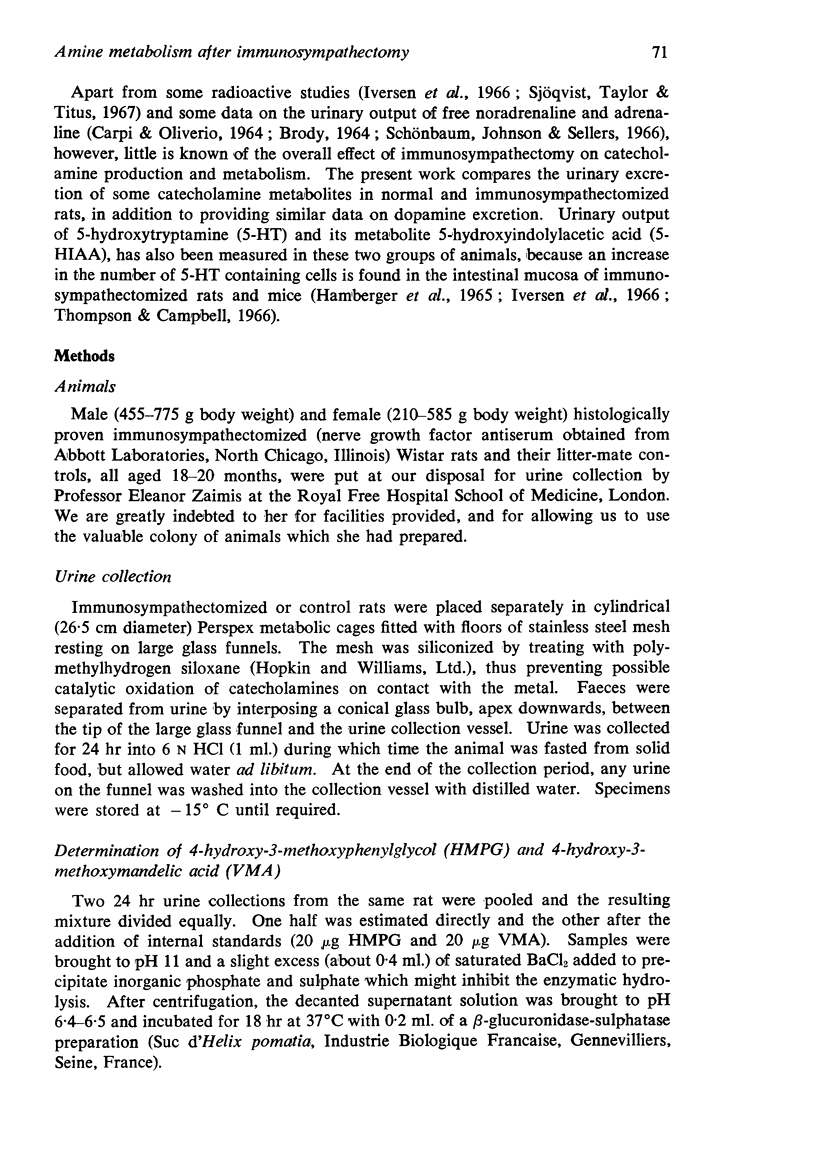
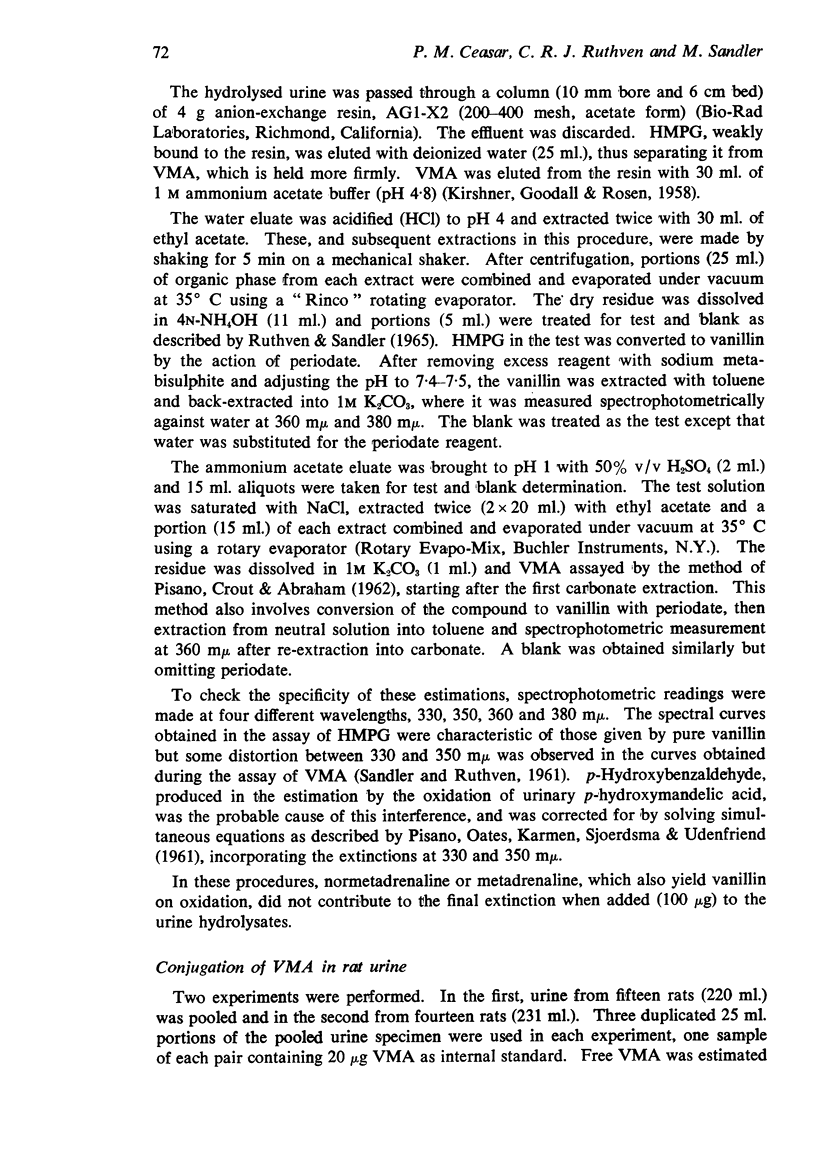
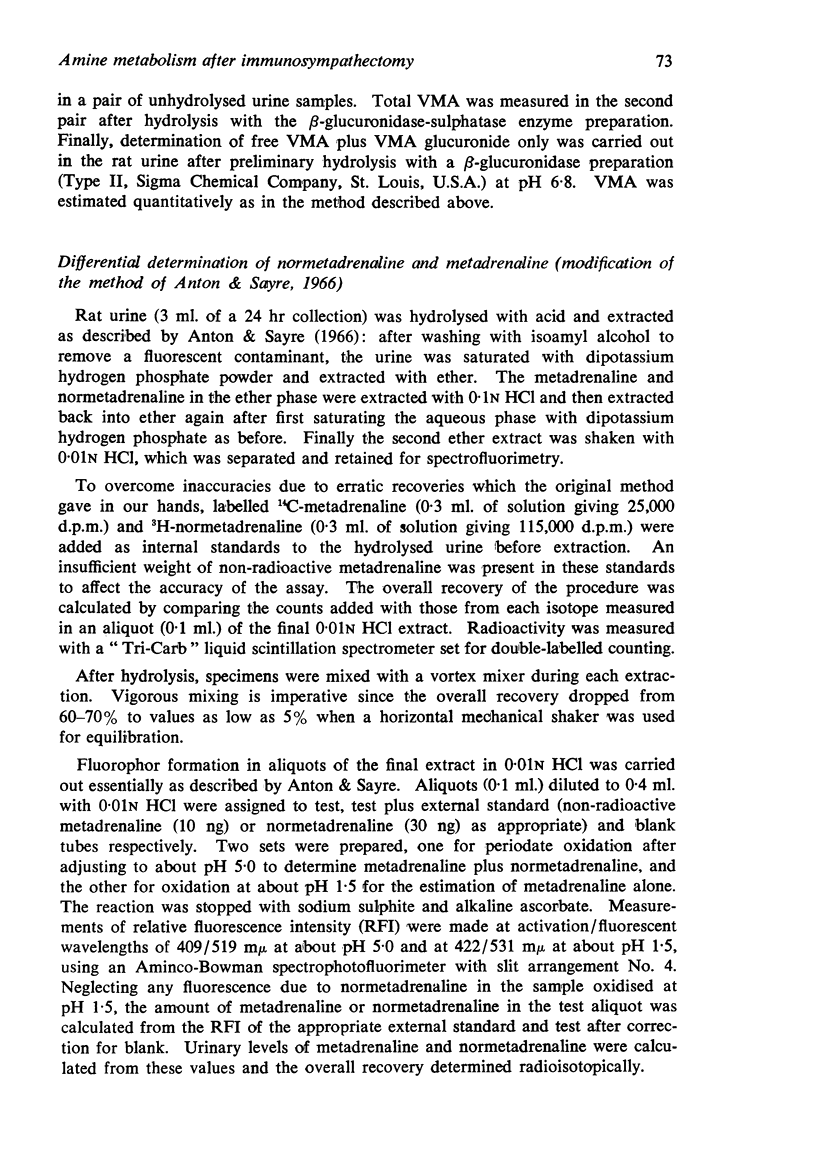
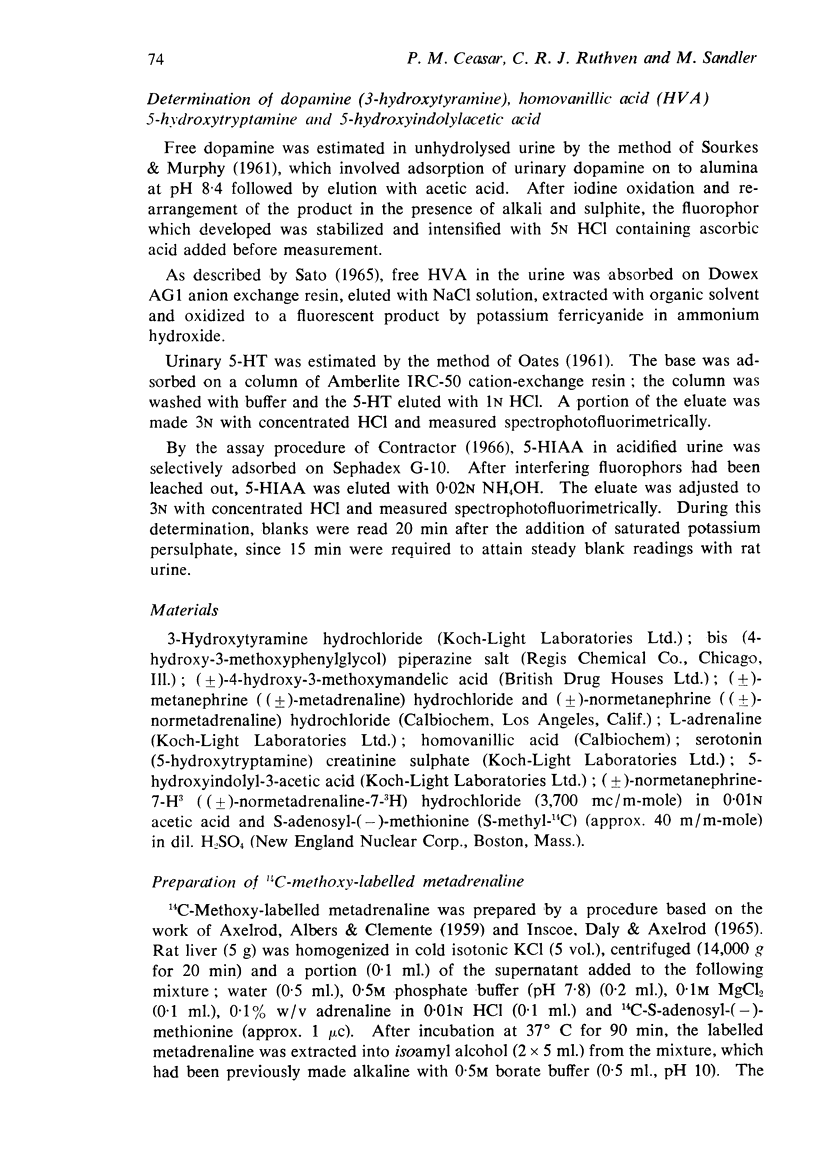
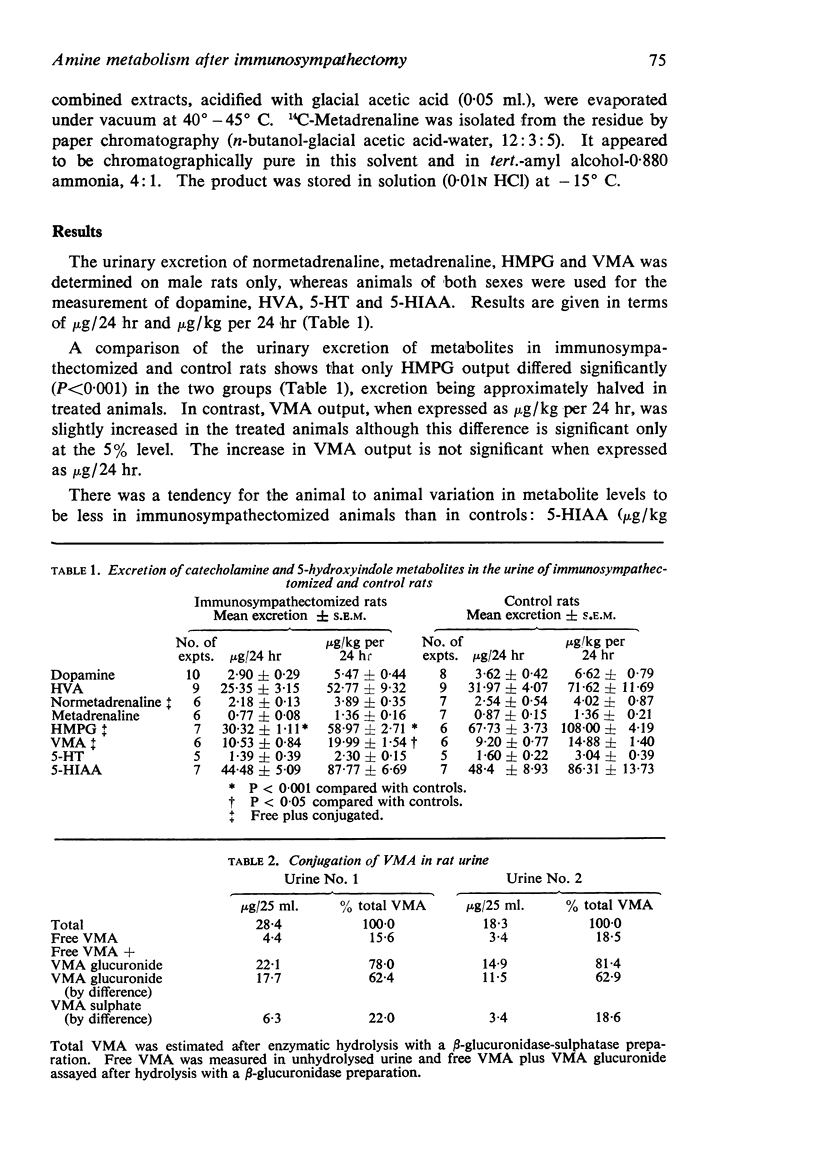
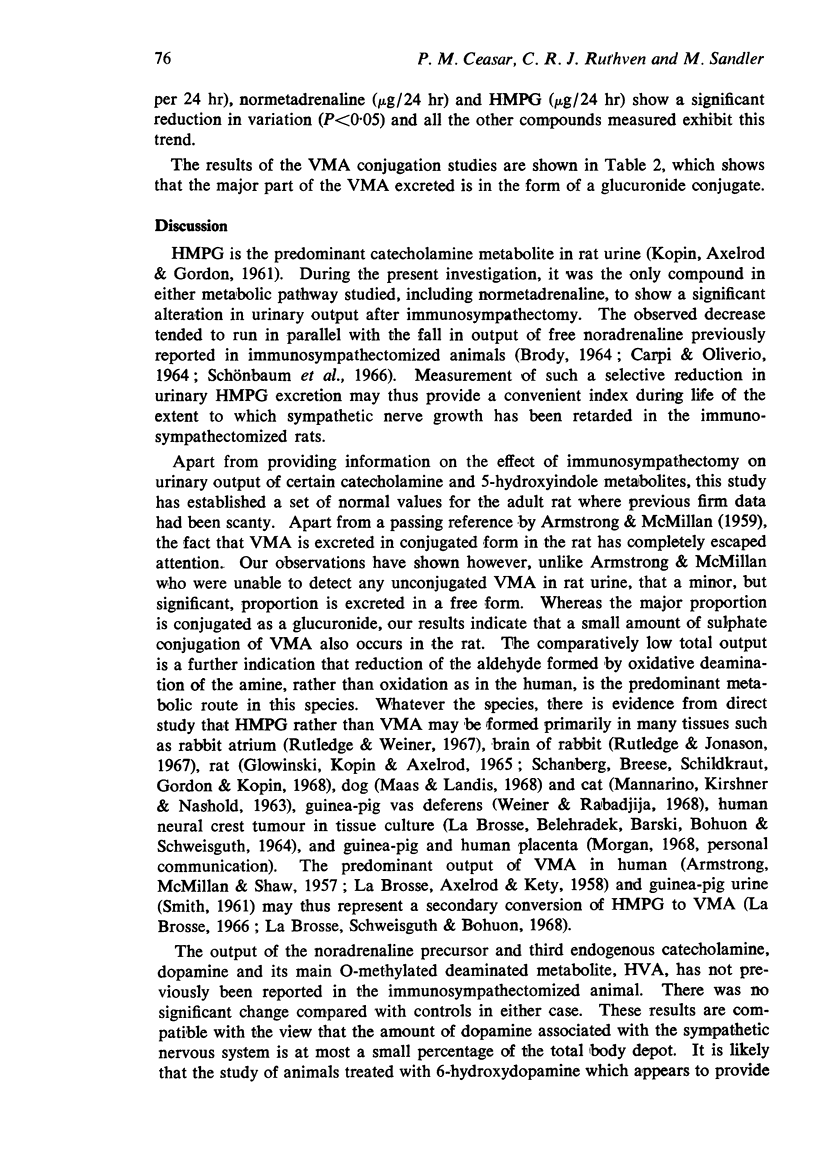
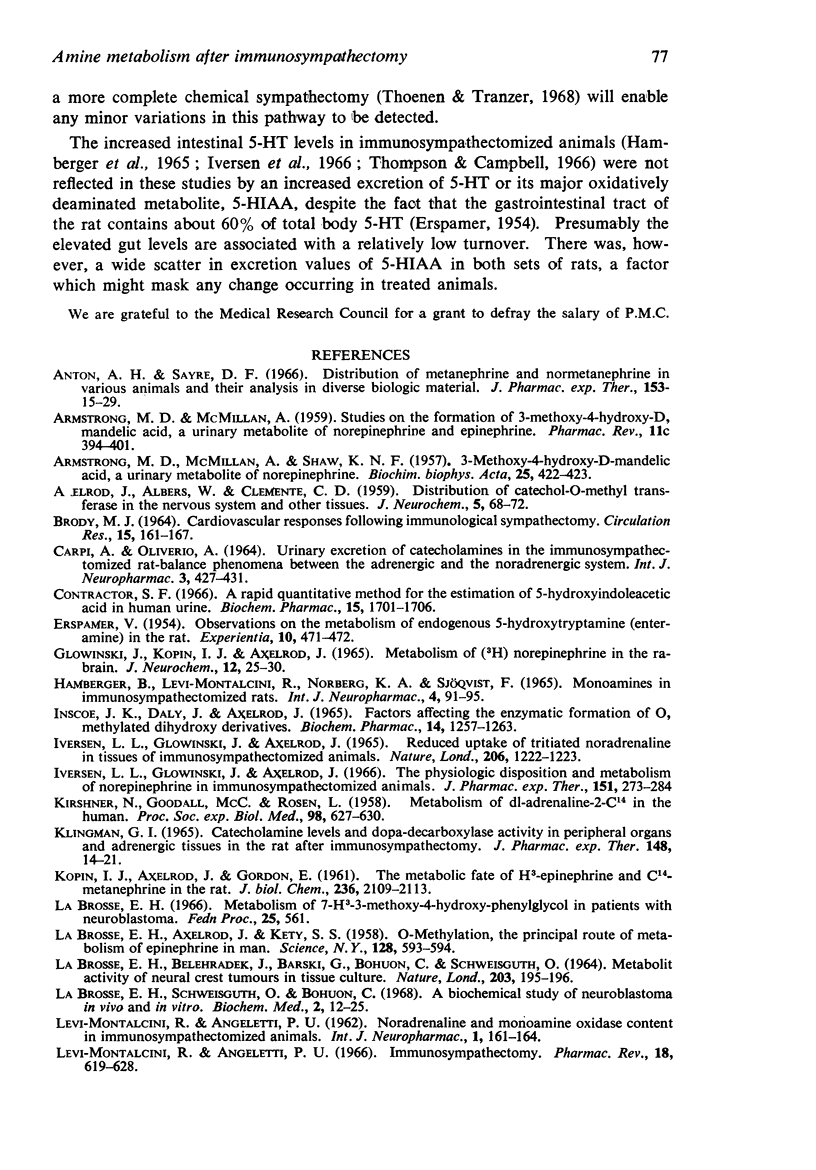
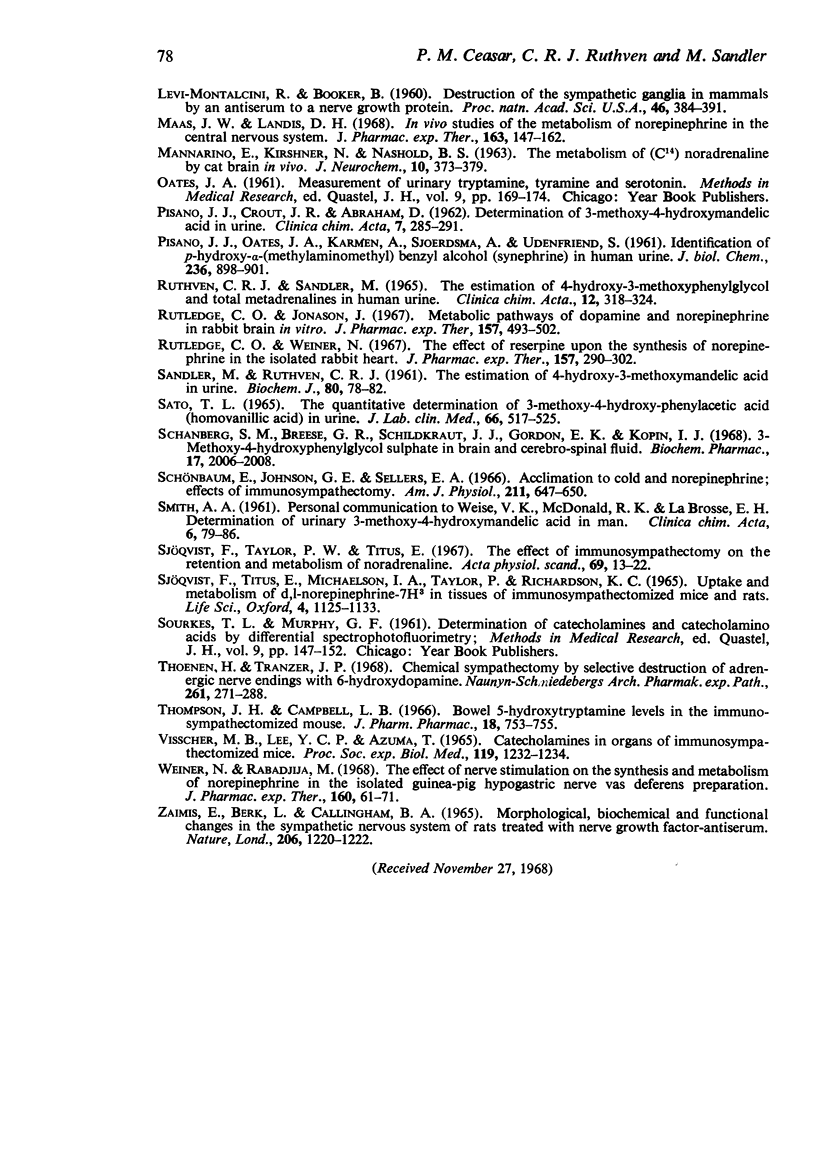
Selected References
These references are in PubMed. This may not be the complete list of references from this article.
- ARMSTRONG M. D., McMILLAN A., SHAW K. N. 3-Methoxy-4-hydroxy-D-mandelic acid, a urinary metabolite of norepinephrine. Biochim Biophys Acta. 1957 Aug;25(2):422–423. doi: 10.1016/0006-3002(57)90491-2. [DOI] [PubMed] [Google Scholar]
- ARMSTRONG M. D., McMILLAN A. Studies on the formation of 3-methoxy-4-hydroxy-D-mandelic acid, a urinary metabolite of norepinephrine and epinephrine. Pharmacol Rev. 1959 Jun;11(2 Pt 2):394–401. [PubMed] [Google Scholar]
- Anton A. H., Sayre D. F. Distribution of metanephrine and normetanephrine in various animals and their analysis in diverse biologic material. J Pharmacol Exp Ther. 1966 Jul;153(1):15–29. [PubMed] [Google Scholar]
- BRODY M. J. CARDIOVASCULAR RESPONSES FOLLOWING IMMUNOLOGICAL SYMPATHECTOMY. Circ Res. 1964 Aug;15:161–167. doi: 10.1161/01.res.15.2.161. [DOI] [PubMed] [Google Scholar]
- CARPI A., OLIVERIO A. URINARY EXCRETION OF CATECHOL AMINES IN THE IMMUNOSYMPATHECTOMIZED RAT--BALANCE PHENOMENA BETWEEN THE ADRENERGIC AND THE NORADRENERGIC SYSTEM. Int J Neuropharmacol. 1964 Sep;3:427–431. doi: 10.1016/0028-3908(64)90073-5. [DOI] [PubMed] [Google Scholar]
- ERSPAMER V. Observations of the metabolism of endogenous 5-hydroxytryptamine (enteramine) in the rat. Experientia. 1954 Nov 15;10(11):471–472. doi: 10.1007/BF02170408. [DOI] [PubMed] [Google Scholar]
- GLOWINSKI J., KOPIN I. J., AXELROD J. METABOLISM OF (H3)NOREPINEPHRINE IN THE RAT BRAIN. J Neurochem. 1965 Jan;12:25–30. doi: 10.1111/j.1471-4159.1965.tb10247.x. [DOI] [PubMed] [Google Scholar]
- HAMBERGER B., LEVI-MONTALCINI R., NORBERG K. A., SJOEQVIST F. MONOAMINES IN IMMUNOSYMPATHECTOMIZED RATS. Int J Neuropharmacol. 1965 Apr;4:91–95. doi: 10.1016/0028-3908(65)90032-8. [DOI] [PubMed] [Google Scholar]
- Inscoe J. K., Daly J., Axelrod J. Factors affecting the enzymatic formation of O-methylated dihydroxy derivatives. Biochem Pharmacol. 1965 Aug;14(8):1257–1263. doi: 10.1016/0006-2952(65)90303-5. [DOI] [PubMed] [Google Scholar]
- Iversen L. L., Glowinski J., Axelrod J. Reduced uptake of tritiated noradrenaline in tissues of immunosympathectomized animals. Nature. 1965 Jun 19;206(990):1222–1223. doi: 10.1038/2061222a0. [DOI] [PubMed] [Google Scholar]
- Iversen L. L., Glowinski J., Axelrod J. The physiologic disposition and metabolism of norepinephrine in immunosympathectomized animals. J Pharmacol Exp Ther. 1966 Feb;151(2):273–284. [PubMed] [Google Scholar]
- KIRSHNER N., GOODALL M., ROSEN L. Metabolism of dl-adrenaline-2-C14 in the human. Proc Soc Exp Biol Med. 1958 Jul;98(3):627–630. doi: 10.3181/00379727-98-24129. [DOI] [PubMed] [Google Scholar]
- KLINGMAN G. I. CATECHOLAMINE LEVELS AND DOPA-DECARBOXYLASE ACTIVITY IN PERIPHERAL ORGANS AND ADRENERGIC TISSUES IN THE RAT AFTER IMMUNOSYMPATHECTOMY. J Pharmacol Exp Ther. 1965 Apr;148:14–21. [PubMed] [Google Scholar]
- KOPIN I. J., AXELROD J., GORDON E. The metabolic fate of H3-epinephrine and C14-metanephrine in the rat. J Biol Chem. 1961 Jul;236:2109–2113. [PubMed] [Google Scholar]
- LABROSSE E. H., AXELROD J., KETY S. S. O-Methylation, the principal route of metabolism of epinephrine in man. Science. 1958 Sep 12;128(3324):593–594. doi: 10.1126/science.128.3324.593. [DOI] [PubMed] [Google Scholar]
- LABROSSE E. H., BELEHRADEK J., BARSKI G., BOHUON C., SCHWEISGUTH O. METABOLIC ACTIVITY OF NEURAL CREST TUMOURS IN TISSUE CULTURE. Nature. 1964 Jul 11;203:195–196. doi: 10.1038/203195b0. [DOI] [PubMed] [Google Scholar]
- Levi-Montalcini R., Angeletti P. U. Second symposium on catecholamines. Modification of sympathetic function. Immunosympathectomy. Pharmacol Rev. 1966 Mar;18(1):619–628. [PubMed] [Google Scholar]
- Levi-Montalcini R., Booker B. DESTRUCTION OF THE SYMPATHETIC GANGLIA IN MAMMALS BY AN ANTISERUM TO A NERVE-GROWTH PROTEIN. Proc Natl Acad Sci U S A. 1960 Mar;46(3):384–391. doi: 10.1073/pnas.46.3.384. [DOI] [PMC free article] [PubMed] [Google Scholar]
- Maas J. W., Landis D. H. In vivo studies of the metabolism of norepinephrine in the central nervous system. J Pharmacol Exp Ther. 1968 Sep;163(1):147–162. [PubMed] [Google Scholar]
- OATES J. A. Measurement of urinary tryptamine, tyramine and serotonin. Methods Med Res. 1961;9:169–174. [PubMed] [Google Scholar]
- PISANO J. J., CROUT J. R., ABRAHAM D. Determination of 3-methoxy-4-hydroxymandelic acid in urine. Clin Chim Acta. 1962 Mar;7:285–291. doi: 10.1016/0009-8981(62)90022-0. [DOI] [PubMed] [Google Scholar]
- PISANO J. J., OATES J. A., Jr, KARMEN A., SJOERDSMA A., UDENFRIEND S. Identification of p-hydroxy-alpha-(methylaminomethyl) benzyl alcohol (synephrine) in human urine. J Biol Chem. 1961 Mar;236:898–901. [PubMed] [Google Scholar]
- Rutledge C. O., Jonason J. Metabolic pathways of dopamine and norepinephrine in rabbit brain in vitro. J Pharmacol Exp Ther. 1967 Sep;157(3):493–502. [PubMed] [Google Scholar]
- Rutledge C. O., Weiner N. The effect of reserpine upon the synthesis of norepinephrine in the isolated rabbit heart. J Pharmacol Exp Ther. 1967 Aug;157(2):290–302. [PubMed] [Google Scholar]
- SANDLER M., RUTHVEN C. R. The estimation of 4-hydroxy-3-methoxymandelic acid in urine. Biochem J. 1961 Jul;80:78–82. doi: 10.1042/bj0800078. [DOI] [PMC free article] [PubMed] [Google Scholar]
- SOURKES T. L., MURPHY G. F. Determination of catecholamines and catecholamino acids by differential spectrophotofluorimetry. Methods Med Res. 1961;9:147–152. [PubMed] [Google Scholar]
- Sato T. L. The quantitative determination of 3-methoxy-4-hydroxyphenylacetic acid (homovanillic acid) in urine. J Lab Clin Med. 1965 Sep;66(3):517–525. [PubMed] [Google Scholar]
- Schanberg S. M., Breese G. R., Schildkraut K. K., Gordon E. K., Kopin I. J. 3-methoxy-4-hydroxyphenylglycol sulfate in brain and cerebrospinal fluid. Biochem Pharmacol. 1968 Sep;17(9):2006–2008. doi: 10.1016/0006-2952(68)90119-6. [DOI] [PubMed] [Google Scholar]
- Schönbaum E., Johnson G. E., Sellers E. A. Acclimation to cold and norepinephrine; effects of immunosympathectomy. Am J Physiol. 1966 Sep;211(3):647–650. doi: 10.1152/ajplegacy.1966.211.3.647. [DOI] [PubMed] [Google Scholar]
- Sjöqvist F., Taylor P. W., Jr, Titus E. The effect of immunosympathectomy on the retention and metabolism of noradrenaline. Acta Physiol Scand. 1967 Jan-Feb;69(1):13–22. doi: 10.1111/j.1748-1716.1967.tb03486.x. [DOI] [PubMed] [Google Scholar]
- Sjöqvist F., Titus E., Michaelson I. A., Taylor P., Jr Uptake and metabolism of d,1-norepinephrine-7H3 in tissues of immunosympathectomized mice and rats. Life Sci. 1965 Jun;4(11):1125–1133. doi: 10.1016/0024-3205(65)90102-5. [DOI] [PubMed] [Google Scholar]
- Thoenen H., Tranzer J. P. Chemical sympathectomy by selective destruction of adrenergic nerve endings with 6-Hydroxydopamine. Naunyn Schmiedebergs Arch Exp Pathol Pharmakol. 1968;261(3):271–288. doi: 10.1007/BF00536990. [DOI] [PubMed] [Google Scholar]
- Thompson J. H., Campbell L. B. Bowel 5-hydroxytryptamine levels in the immunosympathectomised mouse. J Pharm Pharmacol. 1966 Nov;18(11):753–755. doi: 10.1111/j.2042-7158.1966.tb07800.x. [DOI] [PubMed] [Google Scholar]
- Visscher M. B., Lee Y. C., Azuma T. Catecholamines in organs of immunosympathectomized mice. Proc Soc Exp Biol Med. 1965 Aug-Sep;119(4):1232–1234. doi: 10.3181/00379727-119-30422. [DOI] [PubMed] [Google Scholar]
- Weiner N., Rabadjija M. The effect of nerve stimulation on the synthesis and metabolism of norepinephrine in the isolated guinea-pig hypogastric nerve-vas deferens preparation. J Pharmacol Exp Ther. 1968 Mar;160(1):61–71. [PubMed] [Google Scholar]
- Zaimis E., Berk L., Callingham B. A. Morphological, biochemical and functional changes in the sympathetic nervous system of rats treated with nerve growth factor-antiserum. Nature. 1965 Jun 19;206(990):1220–1222. doi: 10.1038/2061220a0. [DOI] [PubMed] [Google Scholar]


